TC
Auto Added by WPeMatico
Auto Added by WPeMatico
In November, we told you about Farmers Business Network, a social network for farmers that invites them to share their data, pool their know-how and bargain more effectively for better pricing from manufacturing companies. At the time, FBN, as it’s known, had just closed on $110 million in new funding in a round that brought its funding to roughly $200 million altogether.
That kind of financial backing might dissuade newcomers to the space, but a months-old startup called AgVend has just raised $1.75 million in seed funding on the premise that, well, FBN is doing it wrong. Specifically, AgVend’s pitch is that manufacturers aren’t so crazy about FBN getting between their offerings and their end users — in large part because FBN is able to secure group discounts on those users’ behalf.
AgVend is instead planning to work directly with manufacturers and retailers, selling their goods through its own site as well as helping them develop their own web shops. The idea is to “protect their channel pricing power,” explains CEO Alexander Reichert, who previously spent more than four years with Euclid Analytics, a company that helps brands monitor and understand their foot traffice. AgVend is their white knight, coming to save them from getting disrupted out of business. “Why cut them out of the equation?” he asks.
Whether farmers will go along is the question. Those who’ve joined FBN can ostensibly save money on seeds, fertilizers, pesticides and more by being invited to comparison shop through FBN’s own online store. It’s not the easiest sell, though. FBN charges farmers $600 per year to access its platform, which is presumably a hurdle for some.
AgVend meanwhile is embracing good-old-fashioned opacity. While it invites farmers to search for products at its own site based on the farmers’ needs and location, it’s only after someone has purchased something that the retailer who sold the items is revealed. The reason: retailers don’t necessarily want to put all of their pricing online and be bound to those numbers, explains Reichert.
Naturally, AgVend insists that it’s not just better for retailers and the manufacturers standing behind them. For one thing, says Reichert, AgVend’s farming customers are sometimes offered rebates. Customers are also better informed about the products they’re buying because the information is coming from the retailers and not a third party, he insists. “When a third party like FBN comes in and tries going around the retailers, the manufacturers can’t guarantee that FBN is giving the right guidance about their products.”
In the end, its customers will decide. But the market looks big enough to support a number of players if they figure out how to play it. According to USDA data from last year, U.S. farms spent an estimated $346.9 billion in 2016 on farm production expenditures.
That’s a lot of feed and fertilizer. It’s no wonder that founders, and the VCs who are writing them checks, see fertile ground. This particular deal was led by 8VC and included the participation of Precursor Ventures, Green Bay Ventures, FJ Labs and House Fund, among others.
Powered by WPeMatico
While chatbots might sound like an interesting experiment for restaurants and other small businesses, they probably can’t devote much time or money to building them. So a startup called Guestfriend is planning to make the process as fast and easy as possible.
The company has raised $5 million in seed funding from Primary Venture Partners, Techstars Ventures and betaworks. It’s led by Bo Peabody, a venture partner and entrepreneur in residence at Greycroft who also co-owns the Mezze Restaurant Group. Peabody compared the current moment to the year 2000, when “every small business woke up and said, ‘I need a website.’”
“That moment is coming for chatbots,” he predicted.
But rather than asking a restaurant owner or employee to go online and design the conversational flow of a chatbot themselves, Guestfriend can automatically create a chatbot based on information that’s already online — hours, menu, support for dietary restrictions and so on. In that sense, Peabody said, “It’s really just a website that you talk to.”
“The ah-ha moment was when I realized that building a bot for my restaurant was virtually impossible to do as a one-off, but all of the answers to almost any question are available online, mostly in structured APIs,” he said.
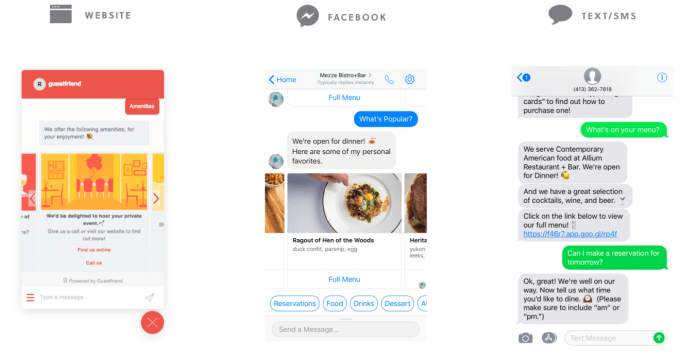
Peabody suggested that the real challenge was building natural language technology that could support the range of questions that someone might ask — for example, all the different ways that people might ask about the dress code. That’s one reason why it was important to target a specific industry, though he eventually plans to expand into home services, retail, spas/salons/exercise and hotels. (“It’s really the Yelp verticals.”)
Guestfriend chatbots work across platforms, including SMS, Facebook, Twitter and Google search results (via Google My Business), with plans to support speech platforms like Amazon Alexa and Google Home.
The company is actually building these chatbots without waiting for restaurants to sign up. (You can try them out on the Guestfriend website.) The idea is that publishers with restaurant listings can also incorporate them as a new way to interact with their sites.
At the same time, restaurants can come in and claim their chatbots, which will be updated accordingly everywhere that they’re available. The restaurant can then be as hands-on or as hands-off as they want.
I brought up the fact that I often visit restaurants’ Facebook Pages in the hopes of answering more timely questions, like whether or not a restaurant is staying open despite bad weather or a holiday. Peabody suggested that as with social media or a website, the up-to-dateness of the information will depend on the restaurant — some of them might want to update every day with things like daily specials. For others, a completely automated approach might be the most appealing.
Powered by WPeMatico
Resy launched in the summer of 2014 with a simple premise: If you want a premium reservation at a restaurant on short notice, you should be able to pay for it. Four years and 160 markets later, Resy has changed a lot since then.
But today, the company is about to change things up even more.
This morning, Resy has announced a brand new suite of tools for restaurants, including a new inventory management system called ResyFly.
As it stands now, restaurants have two options when it comes to inventory management for their reservations. They can choose a slot system, where diners are seated at 6pm, 8pm and 10pm, or they can opt for a flex system, where they take reservations as they’re called in and build the night’s reservations based off what comes in first.
Unfortunately, most restaurants have to choose between these two systems, as there are no inventory management systems that offer the ability to do both, according to Resy.
ResyFly uses Resy’s troves of data to determine the best way for restaurants to eliminate gaps in their inventory throughout a given night, taking into account things like date, time, weather and even the average time spent eating at a given restaurant. The tool gives restaurants the ability to schedule different floor plans, reservation grids and hours of operation for special days like Valentine’s Day.
Alongside ResyFly, the company is also introducing Business Intelligence, a window into important information like KPIs, revenue and ratings with third-party information from platforms like Foursquare layered in and integrated with POS software providers to offer real-time revenue reporting.
But sometimes you want direct feedback from the customer. To that end, Resy is launching Resy Surveys, which gives a restaurant the opportunity to send a custom survey to customers about their experience. Resy is also integrating with Upserve, giving Resy’s restaurant partners insights into their guests’ preferences and favorite dishes, as well as info on dining companions, frequency of bookings and historical spend.
And while Resy is focused on refining the product, the company is also focused on growth. That’s why Resy has announced the launch of Resy Global Service, which lets Resy distribute inventory to partners like Airbnb. (It’s worth noting that Airbnb led Resy’s $13 million funding round in 2017.)
Finally, Resy is working on a new membership loyalty program called Resy Select, which will launch at the end of the month. Resy Select is an invite-only program that gives restaurants insights into Resy’s hungriest users, and gives those users benefits such as exclusive booking windows, priority waitlist, early access tickets to events and other exclusive experiences like meeting the chef or touring the kitchen.
Resy books more than 1 million reservations on the platform each week. The company no longer charges users for reservations, but rather charges restaurants by feature, instead of cover, with three tiers ranging from $189/month to $899/month. That said, the company is not yet self-serve on the restaurant side, but founder and CEO Ben Leventhal said the team is thinking about introducing it in the future.
“The key challenge and key opportunity is to do everything we can to make the right choices about what we build and the order we build it in,” said Leventhal. “Our goal is to stay focused on restaurants, as a significant amount of the tech we build is built in conjunction with our restaurant partners.”
Powered by WPeMatico
This weekend, former Apple engineer and consumer gadget legend Tony Fadell penned an op-ed for Wired. In it, he argued that smartphone manufacturers need to do a better job of educating users about how often they use their mobile phones, and the resulting dangers that overuse might bring about.
Take healthy eating as an analogy: we have advice from scientists and nutritionists on how much protein and carbohydrate we should include in our diet; we have standardised scales to measure our weight against; and we have norms for how much we should exercise.
But when it comes to digital “nourishment”, we don’t know what a “vegetable”, a “protein” or a “fat” is. What is “overweight” or “underweight”? What does a healthy, moderate digital life look like? I think that manufacturers and app developers need to take on this responsibility, before government regulators decide to step in – as with nutritional labelling. Interestingly, we already have digital-detox clinics in the US. I have friends who have sent their children to them. But we need basic tools to help us before it comes to that.
Plenty of studies have shown that too much screen time and internet/smartphone addiction can be damaging to our health, both physically and psychologically. And while there are other players involved in our growing dependence on our phones (yes, I’m talking to you, Facebook), the folks who actually build those screens have ample opportunity to make users more aware of their usage.
In his article, Fadell brings up ways that companies like Apple could build out features for this:
You should be able to see exactly how you spend your time and, if you wish, moderate your behaviour accordingly. We need a “scale” for our digital weight, like we have for our physical weight. Our digital consumption data could look like a calendar with our historical activity. It should be itemised like a credit-card bill, so people can easily see how much time they spend each day on email, for example, or scrolling through posts. Imagine it’s like a health app which tracks metrics such as step count, heart rate and sleep quality.
With this usage information, people could then set their own targets – like they might have a goal for steps to walk each day. Apple could also let users set their device to a “listen-only” or “read-only” mode, without having to crawl through a settings menu, so that you can enjoy reading an e-book without a constant buzz of notifications.
9to5Mac brought up a Bloomberg piece from February that not only shows Apple’s capability to build out this feature, but their willingness to do so for young people, with a reported new feature that would let parents see how much time their kids are staring at their screens.
Unlike Facebook, which has tweaked its algorithm to prioritize meaningful connection over time spent on the platform, Apple’s revenue is not dependent on how much you use your phone. So, maybe we’ll see a digital health feature added to Apple products in the future.
Powered by WPeMatico
Would being asked to pay Facebook to remove ads make you appreciate their value or resent them even more? As Facebook considers offering an ad-free subscription option, there are deeper questions than how much money it could earn. Facebook has the opportunity to let us decide how we compensate it for social networking. But choice doesn’t always make people happy.
In February I explored the idea of how Facebook could disarm data privacy backlash and boost well-being by letting us pay a monthly subscription fee instead of selling our attention to advertisers. The big takeaways were:
However, my analysis neglected some of the psychological fallout of telling people they only get to ditch ads if they can afford it, the loss of ubiquitous reach for advertisers, and the reality of which users would cough up the cash. Though on the other hand, I also neglected the epiphany a price tag could produce for users angry about targeted advertising.
This conversation is relevant because Zuckerberg was asked twice by congress about Facebook potentially offering subscriptions. Zuckerberg endorsed the merits of ad-supported apps, but never ruled out letting users buy a premium version. “We don’t offer an option today for people to pay to not show ads” Zuckerberg said, later elaborating that “Overall, I think that the ads experience is going to be the best one. I think in general, people like not having to pay for a service. A lot of people can’t afford to pay for a service around the world, and this aligns with our mission the best.”
But that word ‘today’ gave a glimmer of hope that we might be able to pay in the future.
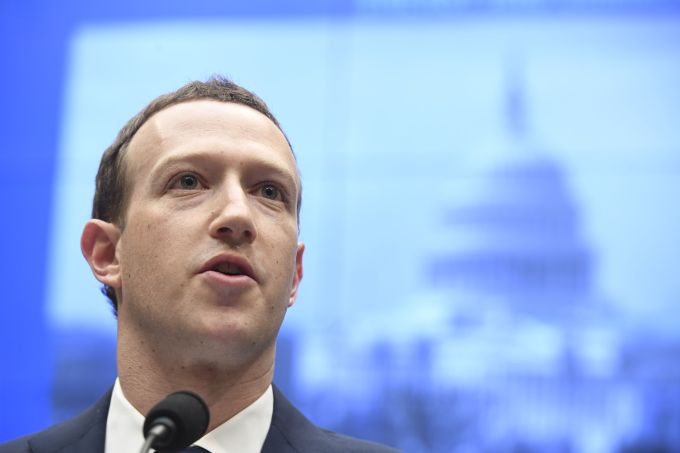
Facebook CEO and founder Mark Zuckerberg testifies during a US House Committee on Energy and Commerce hearing about Facebook on Capitol Hill in Washington, DC, April 11, 2018. (Photo: SAUL LOEB/AFP/Getty Images)
What would we be paying for beyond removing ads, though?. Facebook already lets users concerned about their privacy opt out of some ad targeting, just not seeing ads as a whole. Zuckerberg’s stumping for free Internet services make it seem unlikely that Facebook would build valuable features and reserve them for subscribers
Spotify only lets paid users play any song they want on-demand, while ad-supported users are stuck on shuffle. LinkedIn only lets paid users message anyone they want and appear as a ‘featured applicant’ to hirers, while ad-supported users can only message their connections. Netflix only lets paid users…use it at all.
 But Facebook views social networking as a human right, and would likely want to give all users any extra features it developed like News Feed filters to weed out politics or baby pics. Facebook also probably wouldn’t sell features that break privacy like how LinkedIn subscribers can see who visited their profiles. In fact, I wouldn’t bet on Facebook offering any significant premium-only features beyond removing ads. That could make it a tough sell.
But Facebook views social networking as a human right, and would likely want to give all users any extra features it developed like News Feed filters to weed out politics or baby pics. Facebook also probably wouldn’t sell features that break privacy like how LinkedIn subscribers can see who visited their profiles. In fact, I wouldn’t bet on Facebook offering any significant premium-only features beyond removing ads. That could make it a tough sell.
Meanwhile, advertisers trying to reach every member of a demographic might not want a way for people to pay to opt-out of ads. If they’re trying to promote a new movie, a restaurant chain, or an election campaign, they’d want as strong of penetration amongst their target audience as they can get. A subscription model punches holes in the ubiquity of Facebook ads that drive businesses to the app.
But the biggest issue is that Facebook is just really good at monetizing with ads. For never charging users, it earns a ton of money. $40 billion in 2017. Convincing people to pay more with their wallets than their eyeballs may be difficult. And the ones who want to pay are probably worth much more than the average.
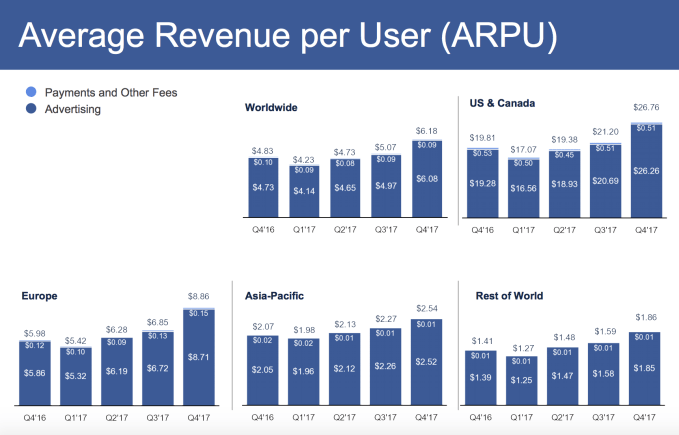
Let’s look at the US & Canada market where Facebook earns the most per user because they’re wealthier and have more disposable income than people in other parts of the world, and therefore command higher ad rates. On average US and Canada users earn Facebook $7 per month from ads. But those willing and able to pay are probably richer than the average user, so luxury businesses pay more to advertise to them, and probably spend more time browsing Facebook than the average user, so they see more of those ads.
Brace for sticker shock, because for Facebook to offset the ad revenue of these rich hardcore users, it might have to charge more like $11 to $14 per month.
With no bonus features, that price for something they can get for free could seem way too high. Many who could afford it still wouldn’t justify it, regardless of how much time they spend on Facebook compared to other media subscriptions they shell out for. Those who truly can’t afford it might suddenly feel more resentment towards the Facebook ads they’ve been scrolling past unperturbed for years. Each one would be a reminder that they don’t have the cash to escape Facebook’s data mines.

But perhaps it’s just as likely that people would feel the exact opposite — that having to see those ads really isn’t so bad when faced with the alternative of a steep subscription price.
People often don’t see worth in what they get for free. Being confronted with a price tag could make them more cognizant of the value exchange they’re voluntarily entering. Social networking costs money to operate, and they have to pay somehow. Seeing ads keeps Facebook’s lights on, its labs full of future products, and its investors happy.
That’s why it might not matter if Facebook can only get 4 percent, or 1 percent, or 0.1 percent of users to pay. It could be worth it for Facebook to build out a subscription option to empower users with a sense of choice and provide perspective on the value they already receive for free.
For more big news about Facebook, check out our recent coverage:
Powered by WPeMatico
Twitter, Vine, Voxer, MessageMe. Facebook has repeatedly cut off competitors from its feature for finding your Facebook friends on their apps… after jumpstarting its own social graph by convincing people to upload their Gmail contacts. Meanwhile, Facebook’s Download Your Information tool merely exports a text list of friends’ names you can’t use elsewhere.
As Congress considers potential regulation following Mark Zuckerberg’s testimonies, it should prioritize leveling the playing field for aspiring alternatives to Facebook and letting consumers choose where to social network. And as a show of good faith and argument against it abusing its monopoly, Facebook should make our friend list truly portable.
It’s time to free the social graph — to treat it as a fundamental digital possession, the way the Telecommunications Act of 1996 protects your right to bring your phone number with you to a new network.
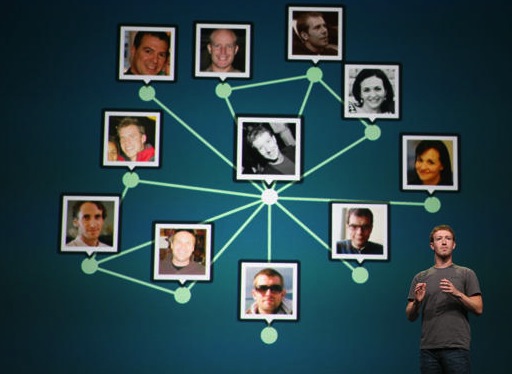
The two most powerful ways to do this would be for Facebook to stop, or Congress to stop it from, blocking friend finding on competitors like it’s done in the past to Twitter and more. And Facebook should change its Download Your Information tool to export our friend list in a truly interoperable format. When you friend someone on Facebook, they’re not just a name. They’re someone specific amongst often many with the same name, and Facebook should be open to us getting connected with them elsewhere.
While it continues til this day, back in 2010 Facebook goaded users to import their Gmail address books so they could add them as Facebook friends. But it refused to let users export the email addresses of their friends to use elsewhere. That led Google to change its policy and require data portability reciprocity from any app using its Contacts API.
So did Facebook back off? No. It built a workaround, giving users a deep link to download their Gmail contacts from Google’s honorable export tool. Facebook then painstakingly explained to users how to upload that file so it could suggest they friend all those contacts.

Google didn’t want to stop users from legitimately exporting their contacts, so it just put up a strongly worded warning to Gmail users: “Trap my contacts now: Hold on a second. Are you super sure you want to import your contact information for your friends into a service that won’t let you get it out? . . . Although we strongly disagree with this data protectionism, the choice is yours. Because, after all, you should have control over your data.” And Google offered to let you “Register a complaint over data protectionism.”
Eight years later, Facebook has grown from a scrappy upstart chasing Google to become one of the biggest, most powerful players on the internet. And it’s still teaching users how to snatch their Gmail contacts’ email addresses while only letting you export the names of your friends — unless they opt-in through an obscure setting, because it considers contact info they’ve shared as their data, not yours. Whether you should be allowed to upload other people’s contact info to a social network is a bigger question. But it is blatant data portability hypocrisy for Facebook to encourage users to import that data from other apps but not export it.
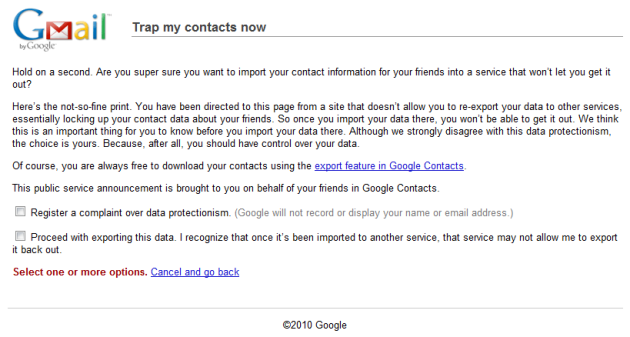
In some respects, it’s good that you can’t mass-export the email addresses of all your Facebook friends. That could enable spamming, which probably isn’t what someone had in mind when they added you as friend on Facebook. They could always block, unfriend or mute you, but they can’t get their email address back. Facebook is already enduring criticism about how it handled data privacy in the wake of the Cambridge Analytica scandal.
Yet the idea that you could find your Facebook friends on other apps is a legitimate reason for the platform to exist. It’s one of the things that’s made Facebook Login so useful and popular. Facebook’s API lets certain apps check to see if your Facebook friends have already signed up, so you can easily follow them or send them a connection request. But Facebook has rescinded that option when it senses true competition.
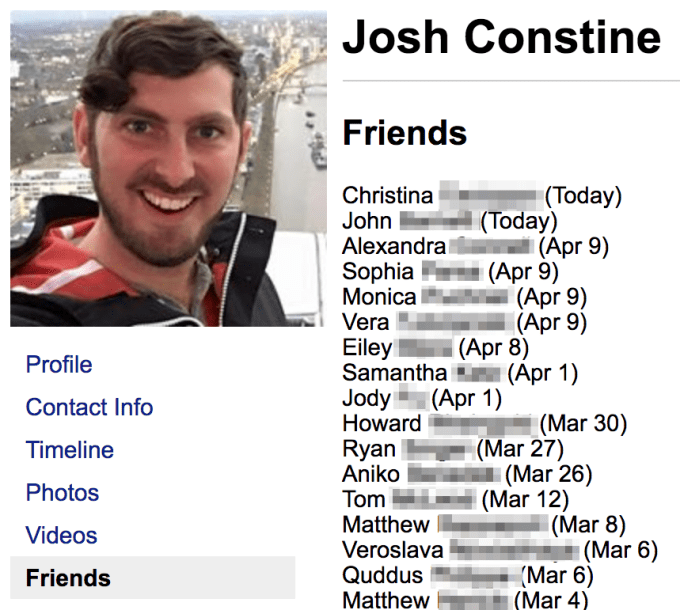 Twitter is the biggest example. Facebook didn’t and still doesn’t let you see which of your Facebook friends are on Twitter, even though it has seven times as many users. Twitter co-founder Ev Williams, frustrated in 2010, said that “They see their social graph as their core asset, and they want to make sure there’s a win-win relationship with anybody who accesses it.”
Twitter is the biggest example. Facebook didn’t and still doesn’t let you see which of your Facebook friends are on Twitter, even though it has seven times as many users. Twitter co-founder Ev Williams, frustrated in 2010, said that “They see their social graph as their core asset, and they want to make sure there’s a win-win relationship with anybody who accesses it.”
Facebook went on to establish a formal policy that said that apps that wanted to use its Find Friends tool had to abide by these rules:
If you use any Facebook APIs to build personalized or social experiences, you must also enable people to easily share their experiences back with people on Facebook.
You may not use Facebook Platform to promote, or to export user data to, a product or service that replicates a core Facebook product or service without our permission.
Essentially, apps that piggybacked on Facebook’s social graph had to let you share back to Facebook, and couldn’t compete with it. It’s a bit ironic, given Facebook’s overarching strategy for years has been “replicate core functionality.” From cloning Twitter’s asymmetrical follow and Trending Topics to Snapchat’s Stories and augmented reality filters, all the way back to cribbing FriendFeed’s News Feed and Facebook’s start as a rip-off of the Winklevii’s HarvardConnection.
Restrictions against replicating core functionality aren’t unheard of in tech. Apple’s iOS won’t let you run an App Store from inside an app, for example. But Facebook’s selective enforcement of the policy is troubling. It simply ignores competing apps that never get popular. Yet if they start to grow into potential rivals, Facebook has swiftly enforced this policy and removed their Find Friends access, often inhibiting further growth and engagement.
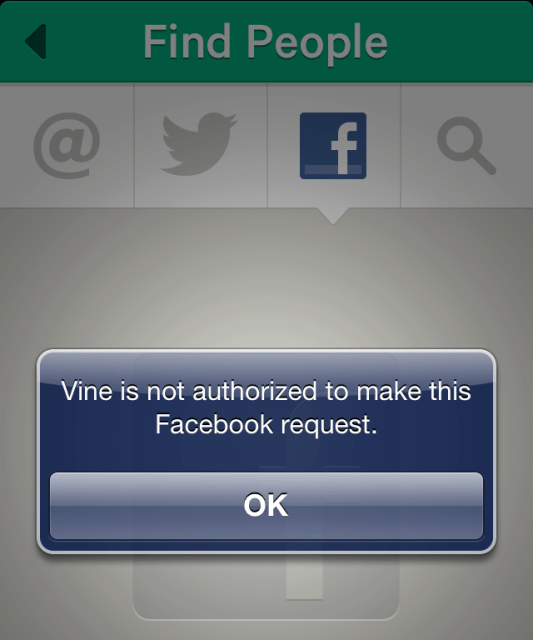 Here are few of examples of times Facebook has cut off competitors from its graph:
Here are few of examples of times Facebook has cut off competitors from its graph:
As I wrote in 2013, “Enforcement of these policies could create a moat around Facebook. It creates a barrier to engagement, retention, and growth for competing companies.” But in 2018, amongst whispers of anti-trust action, Facebook restricting access to its social graph to protect the dominance of its News Feed seems egregiously anti-competitive.
That’s why Facebook should pledge to stop banning competitors from using its Find Friends tool. If not, congress should tell Facebook that this kind of behavior could lead to more stringent regulation.
When Senator John Neely Kennedy asked Zuckerberg this week, “are you willing to give me the right to take my data on Facebook and move it to another social media platform?”, Zuckerberg claimed that “Senator, you can already do that. We have a Download Your Information tool where you can go get a file of all the content there, and then do whatever you want with it.”
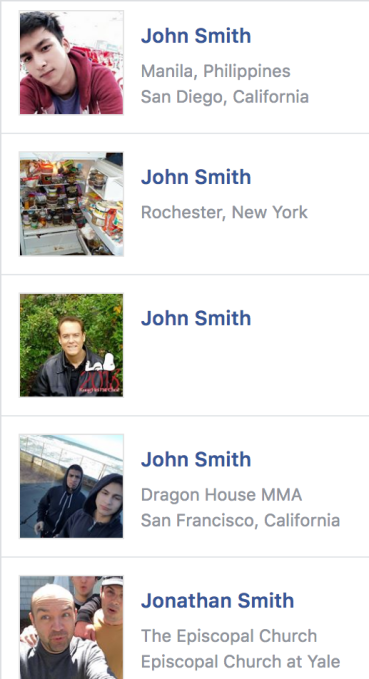 But that’s not exactly true. You can export your photos that can be easily uploaded elsewhere. But your social graph — all those confirmed friend requests — gets reduced to a useless string of text. Download Your Information spits out merely a list of your friends’ names and the dates on which you got connected. There’s no unique username. No link to their Facebook profile. Nothing you can use to find them on another social network beyond manually typing in their names.
But that’s not exactly true. You can export your photos that can be easily uploaded elsewhere. But your social graph — all those confirmed friend requests — gets reduced to a useless string of text. Download Your Information spits out merely a list of your friends’ names and the dates on which you got connected. There’s no unique username. No link to their Facebook profile. Nothing you can use to find them on another social network beyond manually typing in their names.
That’s especially problematic if your friends have common names. There are tons of John Smiths on Facebook, so finding him on another social network with just a name will require a lot of sleuthing, or guess-work. Depending on where you live, locating a particular Garcia, Smirnov or Lee could be quite difficult. Facebook even built a short-lived feature called Friendshake to help you friend someone nearby amongst everyone in their overlapping name space.
When I asked about this, Facebook told me that users can opt-in to having their email or phone number included in the Download Your Information export. But this privacy setting is buried and little-known. Just 4 percent of my friends, centered around tech savvy San Francisco, had enabled it.
As I criticized way back in 2010 when Download Your Information launched, “The data can be used as a diary, or to replace other information from a hard drive crash or stolen computer — but not necessarily to switch to a different social network.”
Given Facebook’s iron grip on the Find Friends API, users deserve decentralized data portability — a way to take their friends with them that Facebook can’t take back. That’s what Download Your Information should offer, but doesn’t.
This is why I’m calling on Facebook to improve the data portability of your friend connections. Give us the same consumer protections that make phone numbers portable.
At the very least Facebook should include your friends’ unique Facebook username and URL. But true portability would mean you could upload the list to another social network to find your friends there.

One option would be for Facebook’s export to include a privacy-safe, hashed version of your friends’ email address that they signed up with and share with you. Facebook could build a hashed email lookup tool so that if you uploaded these nonsensical strings of characters to another app, they could cross-reference them against Facebook’s database of your friends. If there’s a match, the app could surface that person as someone with whom you might want to reconnect. Effectively, this would let you find friends elsewhere via email address without Facebook ever giving you or other apps a human-readable list of their contact info.
If you can’t take your social graph with you, there’s little chance for a viable alternative to Facebook to arise. It doesn’t matter if a better social network emerges, or if Facebook disrespects your privacy, because there’s nowhere to go. Opening up the social graph would require Facebook to compete on the merit of its product and policies. Trying to force the company’s hand with a variety of privacy regulations won’t solve the core issue. But the prospect of users actually being able to leave would let the market compel Facebook to treat us better.
For more on Facebook’s challenges with data privacy, check out TechCrunch’s feature stories:
Powered by WPeMatico
You’ll soon be able to draw on the world around you and shoot back-and-forth Instagram Boomerang GIFs with the Facebook Camera. Bringing additional creative tools to the Facebook Camera could make it a more popular place to shoot content and help the company compete with Snapchat.
“We wanted to give people an easy way to create with augmented reality and draw in the world around them” says John Barnett, a Facebook Camera Product Manager about the feature it calls “3D drawing”. It’s rolling out to users over the coming weeks. Matt Navarra first spotted the features.
With AR drawing, you can scribble on the world around you, then move your camera and see the markings stay in place. It’s a fun way to add graffiti that only exists inside your screen. You can add the drawings before or while you’re recording, allowing you to draw on something out of frame, then pan or unzoom to reveal it. Facebook will eventually add more brushes beyond the pastel gradient colors seen here.
Facebook tells me the technology understands the corners and objects in the room to create a 3D spec. Facebook could that use that to detect surfaces like walls and tables to wrap the drawing onto them. Currently, it only does that when it’s confident about the object recognition, such as in optimal light conditions.
Since drawing is a universal language, the feature could make AR easy to use for younger users and Internet novices. Facebook launched its AR effects at F8 last April, and has recently added AR tracker target experiences that are triggered by real-world posters or QR codes. It all started with the company acquiring fledgling AR masks startup MSQRD in 2016.
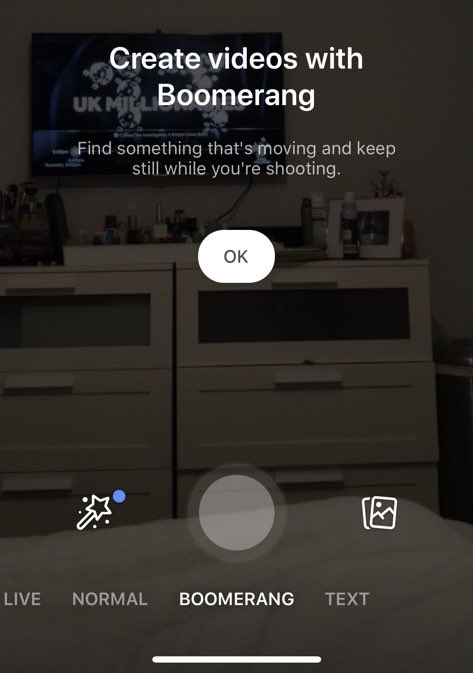 Facebook added looping GIF creation to the Facebook Camera a year ago, but those can feel a bit jarring since they start back at the beginning once they end. Some users no longer have that GIF option, so it’s potentially being replaced by Boomerang’s established brand and more silky back-and-forth animated video clips. Facebook confirms that this feature is now rolling out to the Facebook Camera.
Facebook added looping GIF creation to the Facebook Camera a year ago, but those can feel a bit jarring since they start back at the beginning once they end. Some users no longer have that GIF option, so it’s potentially being replaced by Boomerang’s established brand and more silky back-and-forth animated video clips. Facebook confirms that this feature is now rolling out to the Facebook Camera.
As we reported last week, Facebook is determined to make Stories work. Despite the criticism of it being a rip-off of Snapchat and redundant given Instagram Stories, Facebook is trying new ways to make Stories more popular an accessible. That includes tests of Stories as the default destination for content shot with the Facebook Camera, showing bigger tiles with previews of Stories atop the News Feed, and showing a camera and camera roll preview window when you open the status composer. Those, combined with these new features, could give Facebook Stories a boost in utility and visibility.
Facebook believes social media is on an inevitable journey from text to photos to videos to Stories equipped with augmented reality. Since Snapchat refused its acquisition offers, Facebook is now on a quest to evolve into an AR company rather than having to buy a big one. It remains to be seen whether users think AR is a novelty or a core utility, but Facebook won’t wait to find out.
Powered by WPeMatico
Subscription biller Zuora was well-received by stock market investors on Thursday, following its public debut. After pricing its IPO at $14 and raising $154 million, the company closed at $20, valuing the company around $2 billion.
It was also much higher than expected. The company said in its filings that it planned to price its shares between $9 and $11, before it raised that range to $11 to $13.
Founder and CEO Tien Tzuo told TechCrunch that he believes “a bet on us is really a bet on an entire shift to a new business model, to a subscription economy.” He is optimistic that subscriptions are the “business model of the future.”
Zuora sees itself as an early pioneer in a growing category. The company believes that more businesses will shift their business models to subscriptions, across sectors like media and entertainment, transportation, publishing, industrial goods and retail.
It helps its 950 customers manage subscriptions, including billing and revenue recognition. Zuora touts that it has 15 of the Fortune 100 businesses as clients.
Zuora’s revenue for its fiscal 2018 year was $167.9 million. This was up from $113 million in 2017 and $92.2 million the year before. Losses remained constant in this time frame, from $48.2 million in 2016 to $47.2 million in 2018.
“We have a history of net losses, anticipate increasing our operating expenses in the future, and may not achieve or sustain profitability,” warned the requisite risk factors section of the filing.
It also acknowledged a competitive landscape. Oracle and SAP are amongst the companies offering software in the ERP (enterprise resource planning) category. It also competes with other startups like Chargebee and Chargify.
The largest shareholders are Benchmark, which owned 11.1 percent prior to the IPO. Founder and CEO Tien Tzuo owned 10.2 percent. Others with a significant stake included Wellington Management, Shasta Ventures, Tenaya Capital and Redpoint.
The San Mateo, Calif.-based company previously raised more than $240 million, dating back to 2007.
Zuora listed on the New York Stock Exchange, under the ticker “ZUO.” Goldman Sachs and Morgan Stanley worked as lead underwriters on the deal. Fenwick & West and Wilson Sonsini served as counsel.
After a slow start to the year for tech IPOs, there has been a flurry of activity in recent weeks. Dropbox and Spotify were amongst the recent public debuts. We also have DocuSign, Pivotal and Smartsheet on the horizon.
Powered by WPeMatico
The record-setting score that settled the Donkey Kong arcade rivalry, made famous by the documentary The King of Kong, has been invalidated by Twin Galaxies, the de facto arbiter of arcade world records. What’s more, Billy Mitchell, the occasionally controversial player who set the scores, has been permanently banned from consideration for future records.
It’s a huge upset that calls into question decades of history. Will other similarly disputed scores get the ax? Are any old-school arcade legends safe?
Before anything, it should be noted that although this sounds like kind of a random niche issue, the classic gaming scene is huge and millions follow it closely and take it very seriously. Breaking a high score on a 30-year-old game or shaving a quarter of a second off a record time can and will be celebrated as if the player has won an Olympic medal. One can never underestimate the size or sincerity of online communities. Cheating is, of course, not tolerated.
With that said, it’s worth considering that Billy Mitchell’s case is unique. He is undoubtedly a highly skilled player and has been setting records since the ’80s. But, as anyone who watched The King of Kong will have learned, he’s also a bit shady and his Donkey Kong acumen is far from established.
The issue is simply that despite having provided tapes of games setting records — including being the first to break a million in Donkey Kong — no one has seen him play like that in person.
That may sound like a red flag, but in the speedrunning and record-setting community, a great deal of practice happens alone, in an empty arcade, or otherwise with no credible witnesses (though Twitch has changed that). You could set a world record while in the zone after getting home from work, but it doesn’t count unless it’s reviewed and accredited by a neutral party. Twin Galaxies is the largest organization performing that duty, and they take it very seriously indeed.

The final score on Mitchell’s disputed tape showing in The King of Kong (the leading 1 is omitted because the digits roll over when you reach a million).
You may remember that at the end of The King of Kong, Mitchell reestablishes his supremacy over plucky local kid Steve Wiebe with a “direct capture” tape of a run scoring 1,047,200 points. There are no witnesses to this game. Shortly after this, he also recorded a 1,050,200 score, also not witnessed. And just a week before being inducted into the International Video Game Hall of Fame in Iowa, he set records in both Donkey Kong (1,062,800) and Donkey Kong 2.
Now here’s where things get dicey (and nerdy).
Jeremy Young, aka Xelnia, put together the official two-part complaint on Twin Galaxies. For one part of it, he mentioned the suspicions some already had regarding the evidence set forth of the last and highest score Mitchell set, in an arcade called Boomers.
As others had already pointed out, not only are the run itself and resulting score not shown in the video, but the referee is among the least reliable, and the timeline is unclear, among other things. Most damning, however, it is clear that when Mitchell’s confederate ostentatiously “swaps out” the Donkey Kong board (so it can be verified elsewhere) for a Donkey Kong Jr. one (which Mitchell supposedly later set a record on), both PCBs were in fact the latter.
 Twin Galaxies user Robert.F explained the differences in charming internet forum argot:
Twin Galaxies user Robert.F explained the differences in charming internet forum argot:
to a UN-trained train eye Dk and DKjr look the same and in fact they are vary similar, except for a few noticeable differences…the DK pcb has white text on the pcb and the Dk jr has banana yellow text printed on the board ,, the DK pcb is 1/2 digital and 1/2 Analog sound and there is a adjustment pot on the dk pcb for the Analog sound`s, The Dk Jr board is fully digital and has no Analog sound adjustment pot in the exact same position on the dkjr board, and the 3rd noticeable differences and you will see; it if you review the video carefully Dk has the same ROM socket lay out and the same number of sockets as a Dkjr pcb ,, But DKjr has one of them ROM socket empty ,,,,,,
But these circumstantial issues could be explained as a bit of confusion in the moment, a misspoken word in their excitement, and so on. Fortunately, that wasn’t the extent of the evidence.
As you may know, emulators are a type of application made to run old software (like arcade games) as closely as possible to how it ran on the original hardware. MAME is by far the most complex and perhaps the best-known emulator; this amazing app can emulate everything from Donkey Kong to much more recent games with complex 3D graphics. Of course, MAME runs aren’t accepted for world records — you could easily manipulate the software or even the game data itself. Real arcade hardware is required.
But MAME isn’t perfect; there are tiny differences in how it displays graphics — things you wouldn’t notice unless you were watching a game frame by frame looking for them in particular.
Which is exactly what people started doing with Mitchell’s no-witnesses, only-on-video scores.
It turns out that the original Donkey Kong PCBs had a specific method of rendering a scene during graphics transitions called a “sliding door effect,” distinctive in the pattern of how pixels are updated. Careful inspection of Mitchell’s tapes showed not a sliding door, but instead a distinctive artifact of MAME emulation whereby the frame is rendered in chunks according to how the data is loaded from memory.
You can see the similarity in the GIFs below, provided as evidence by Young.
First is footage of an actual machine taken at 60FPS. Note the diagonal “sliding door” that reveals the scene from the top left downwards:
 Next, Mitchell’s 1,050,200 run:
Next, Mitchell’s 1,050,200 run:
 Last, how MAME renders a similar scene:
Last, how MAME renders a similar scene:
 See how the ladders come in all at once in that pattern, and there’s no sliding door? As you can tell, it’s something of a smoking gun. Certainly Twin Galaxies investigators thought so. In their conclusions, issued today on the forums, they wrote (emphasis theirs):
See how the ladders come in all at once in that pattern, and there’s no sliding door? As you can tell, it’s something of a smoking gun. Certainly Twin Galaxies investigators thought so. In their conclusions, issued today on the forums, they wrote (emphasis theirs):
The taped Donkey Kong score performances of 1,047,200 (the King of Kong “tape”), 1,050,200 (the Mortgage Brokers score) that were historically used by Twin Galaxies to substantiate those scores and place them in the database were not produced by the direct feed output of an original unmodified Donkey Kong Arcade PCB.
They decline to go so far as saying they know it was MAME, but that’s a mere scruple — everyone understands it’s the most likely situation. Regardless, the very fact that Mitchell passed off non-authentic footage as real is more than enough to strike his scores and, as they also announce, ban him from further placement anywhere in the system.
Perhaps more importantly, Steve Wiebe, the underdog challenger in The King of Kong, has been elevated to become the first player to actually hit a million points in the game. Better late than never! Belated congratulations to Wiebe. (Wikipedia has already been updated.)
Mitchell, on the other hand, has remained out of sight during the investigation that has gone on these last few months, and has essentially been ruined for good in the arcade world. Even if he were to set a world record today (and existing record holders doubt he has the skill to do so based on reviewing his play), it would be tainted by years of proven deception. The community won’t forgive him.
And that’s the worry others are voicing: Will the investigators come for other scores that for years have been venerated but have not been verified as strictly as modern records are? Will, for example, any score without an accredited witness or reliable recording be removed from the lists?
In their decision, Twin Galaxies’ authorities write:
Twin Galaxies is dedicated to absolutely rooting out invalid scores from our historic database wherever we find them.
Our methodic approach has allowed many things to surface, not only related to this specific score, but other scores as well as some previously never-before-discussed video game related history.
We must repeat, the truth is the priority. That is the concern. Whatever it takes.
This dispute is closed, and a controversial but nevertheless legendary gaming figure covered in shame (or he should be if he has any). Who will be next? Regardless of who falls, the community will no doubt continue to thrive; the passion for these old games is undying and, as new generations have shown, is not limited to an aging cohort of Gen-Xers striving to extend a bygone era of glory (though admittedly they are a big part of it).
If this strange saga interested you anywhere near as much as it interested me, go ahead and dive in. You might find you have a new hobby. Just don’t try to fake it. And by the way, the current top score in Donkey Kong is 1,247,700, set just two months ago by Robbie Lakeman. Good luck.
Powered by WPeMatico
Disrupt lands in San Francisco this September, and the agenda is shaping up to be absolutely amazing.
With new digs at Moscone West and expanded capacity, we expect Disrupt SF (September 5-7) to be the biggest and best conference TechCrunch has ever had. And, in large part, that’s credited to our incredible guests.
Today, we’re pleased to announce that GirlBoss Media CEO Sophia Amoruso, as well as Carbon CEO Dr. Joseph DeSimone and Adidas CMO Eric Liedtke, will be joining us on the Disrupt stage.
It’s been four years since GirlBoss Sophia Amoruso graced the Disrupt stage.
A lot has changed since then. Amoruso stepped down as CEO of Nasty Gal, which soon after filed for bankruptcy. She exposed her personal life, and faced harsh criticism, on a brief Netflix original series called GirlBoss.
But Amoruso is neither down nor out. The serial entrepreneur has started another venture by a familiar name. Amoruso described GirlBoss Media to investors as “Oprah for millennials and Supreme with boobs.”
Inspired by Amoruso’s memoir #GirlBoss, GirlBoss Media aims to motivate women to take action in their lives.
There’s something spectacular about falling off the horse and getting back up again, and we’re extremely excited to hear Amoruso tell her story in her own words on the Disrupt SF stage in September.
Bonus: We’re bringing in former TechCrunch co-editor Alexia Tsotsis to conduct the interview, four years after she interviewed Amoruso at Disrupt NY 2014. Tsotsis is now the founder of an SF-based seed-stage fund called Dream Machine.
You might not equate sneakers with technological advancement, but Carbon and Adidas could quickly prove you wrong.
Carbon, the 3D printing startup that has raised more than $420 million, has fundamentally changed manufacturing by creating a proprietary CLIP tech that speeds up the process of additive manufacturing by leaps and bounds.
Looking for proof of concept? Look no further than Adidas, who has invested in Carbon to help manufacture its 3D-printed Futurecraft sneakers. Carbon’s 3D printers (in relatively small numbers) are able to build out particularly impressive mid-soles, which feature 20,000 struts, a feat that would be far more difficult and exhaustive to accomplish through traditional manufacturing.
That said, Carbon is scaling quickly, with the duet planning to print shoes in the ‘hundreds of thousands of pairs’ this year, jumping to the millions by 2019.
Carbon co-founder and CEO Dr. Joseph DeSimone (winner of the $500K Lemelson-MIT prize in 2008) and Adidas Executive Board Member (global brands) Eric Liedtke (named 2017 CMO of the year in Germany) will join us on stage to discuss a range of topics, from upending traditional manufacturing to the relationship between incumbents and disruptive startups.
Disrupt SF runs from September 5 to September 7 at Moscone West. Passes to attend are now available at Super Early Bird pricing.
Powered by WPeMatico